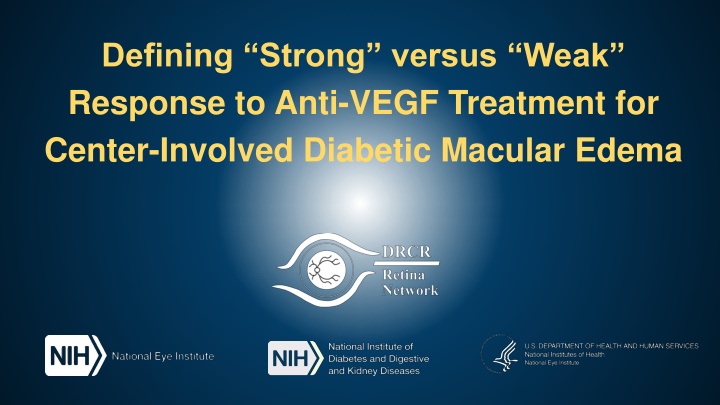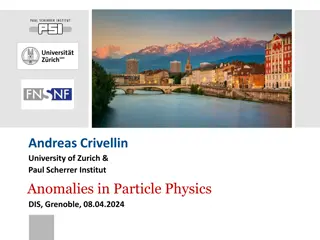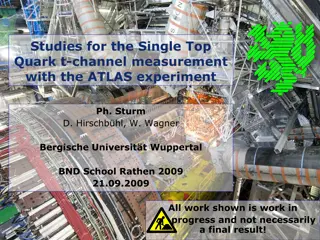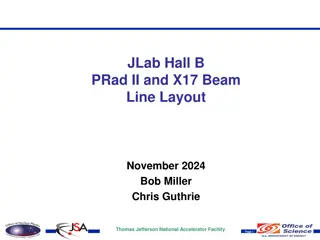
Characterizing Treatment Response in Diabetic Macular Edema
Explore the differentiation between strong and weak responses to anti-VEGF treatment for center-involved diabetic macular edema. Emphasizing the need for standardized definitions to predict treatment outcomes and improve future studies. Objective: Develop consistent phenotypes for visual and anatomic outcomes applicable to individuals and populations undergoing anti-VEGF therapy. Methods involve analyzing data from prior DRCR studies on eyes with varying baseline visual acuity treated with ranibizumab, aflibercept, and bevacizumab. Baseline characteristics of the study cohorts are detailed.
Download Presentation

Please find below an Image/Link to download the presentation.
The content on the website is provided AS IS for your information and personal use only. It may not be sold, licensed, or shared on other websites without obtaining consent from the author. If you encounter any issues during the download, it is possible that the publisher has removed the file from their server.
You are allowed to download the files provided on this website for personal or commercial use, subject to the condition that they are used lawfully. All files are the property of their respective owners.
The content on the website is provided AS IS for your information and personal use only. It may not be sold, licensed, or shared on other websites without obtaining consent from the author.
E N D
Presentation Transcript
Defining Strong versus Weak Response to Anti-VEGF Treatment for Center-Involved Diabetic Macular Edema
Motivation DME is a leading cause of vision loss Most eyes treated with anti-VEGF for DME do not achieve 20/20 vision or complete resolution of thickening How can we predict which eyes will respond well to treatment? Addressing this question is limited by lack of agreement on definitions of treatment response As the Network engages in future studies (including AI and Genetics studies), we need to provide guidance as to relevant and useful definitions of DME treatment response 2
Defining Treatment Response Mean change in VA and CST are often assessed in clinical trials Statistics from continuous outcomes describe a population, not an individual Binary outcomes, such as gain of 15 or more letters, are often reported as secondary outcomes The likelihood of gaining 15 or more letters is highly dependent upon the baseline visual acuity The relevant outcome for an eye starting at 20/80 is likely different than an eye starting at 20/25 Changes in CST are also dependent on baseline CST 3
Objective Characterize visual and anatomic outcomes for eyes treated with anti-VEGF for DME Develop standardized phenotypes of treatment response for future studies Clinically relevant Applicable to individuals and populations Stable across cohorts with varying characteristics Address functional and structural success 4
Methods Exploratory analysis of data from anti-VEGF groups in prior DRCR studies Protocol I (ranibizumab) Eyes with baseline VA of 20/32 to 20/320 Protocol T (aflibercept, bevacizumab, and ranibizumab) Eyes with baseline VA of 20/32 to 20/320 Protocol V (aflibercept) Limited to eyes with baseline VA of 20/25 Must have available VA and CST data at baseline and 24 weeks 5
Baseline Characteristics Protocol All (n=958) 61 I (n=303) 63 T (n=592) 60 V (n=63) 60 Age (y), median Sex Female Male Race/Ethnicity White Black/African American Hispanic or Latino Visual acuity (letters), median (Snellen equivalent) Central subfield thickness (Stratus equivalent, m), median 46% 54% 45% 55% 46% 54% 56% 44% 68% 15% 14% 71% 16% 10% 67% 15% 16% 60% 14% 19% 68 (20/50) 65 (20/50) 69 (20/40) 82 (20/25) 378 389 388 295 6
Continuous VA Outcomes at 24 Weeks Mean change in VA over 24 weeks is highly associated with baseline VA Eyes with worse baseline VA are more likely to gain more vision with treatment 7
Baseline CST Subgroups Interpretation of CST is dependent upon machine and participant sex We defined subgroups based on the number of microns above the CI-DME threshold established by DRCR: <75 m, 75 to <175 m, and 175 m above CI-DME thresholds CI-DME thresholds: Spectralis: 305 m for women, 320 m for men Cirrus: 290 for women, 305 for men Stratus: 250 for both sexes 9
Continuous CST Outcomes at 24 Weeks 10
Categorical Phenotype at 24 vs 104 Weeks 13
Anti-VEGF Injections by 104-Week Response 14
Model-Based Phenotypes We fit equations to estimate change in VA and CST at 24 weeks as a continuous function of baseline VA and CST More precise than baseline categories Strong response was defined as meeting or exceeding the expected value from the regression equation 15
Model-Based Phenotype Threshold Values Baseline CST above CI-DME Threshold, m 0 50 100 150 200 250 300 350 Threshold for Strong Response, m -15 -51 -87 -123 -159 -195 -231 -267 Baseline Visual Acuity Letter Score (Snellen Equivalent) 80 (20/25) 75 (20/32) 70 (20/40) 65 (20/50) 60 (20/63) 55 (20/80) 50 (20/100) 45 (20/125) 40 (20/160) 35 (20/200) 30 (20/250) 25 (20/320) Threshold for Strong Response, Letters 5 7 8 10 12 13 15 17 18 20 22 23 16
Model-Based Phenotype: Visual Acuity Strong Response Weak Response Strong response if change in VA 31.08 0.33 Baseline visual acuity 17
Model-Based Phenotype: Central Subfield Thickness Strong response if change in CST -15.96 0.72 (Baseline CST CI-DME Threshold) 18
Model-Based Phenotype at 24 vs 104 Weeks 19
Conclusions and Future Directions The development of standardized methods to categorize eyes as having strong versus weak response to anti-VEGF treatment will be beneficial for future research efforts addressing eyes with DME These phenotypes might aid efforts to identify targets beyond VEGF for future therapeutic investigations These definitions will be used in future DRCR pharmacogenetic studies, efforts to identify predictive biomarkers, and in artificial intelligence initiatives using retinal images 20




















